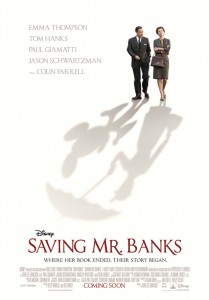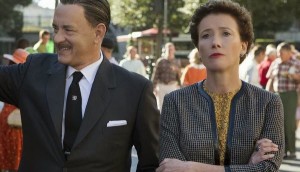 The “story behind the story” is a common theme to movies, seen in such films as “Ed Wood, ” “Hugo,” and the movie “Hitchcock.” They are a glimpse behind the curtain of film directors; a way to see how their “product” was made. “Saving Mr. Banks” tells the story of P.L. Travers, and of her inspiration behind the character Mary Poppins. It also deals with her interactions with Walt Disney later on in life, and of his determination to purchase the movie rights from her. Although this may not satisfy every Disney lover, “Saving Mr. Banks” is a thoughtful, engaging film.
The “story behind the story” is a common theme to movies, seen in such films as “Ed Wood, ” “Hugo,” and the movie “Hitchcock.” They are a glimpse behind the curtain of film directors; a way to see how their “product” was made. “Saving Mr. Banks” tells the story of P.L. Travers, and of her inspiration behind the character Mary Poppins. It also deals with her interactions with Walt Disney later on in life, and of his determination to purchase the movie rights from her. Although this may not satisfy every Disney lover, “Saving Mr. Banks” is a thoughtful, engaging film.
“Saving Mr. Banks” is told in two timelines. The first begins in 1910, where P.L. Travers is a young girl living in the countryside of Australia. Her unhappy childhood is broken only by occasional tender moments with her warming, although also alcoholic father (Colin Farrell). When her father falls ill, her Aunt Ellie (Rachel Griffiths) comes to help them. Dressed in a black dress and hat, with a parrot umbrella; she is the spitting image of Mary Poppins. Fast forward 50 years, to 1961. Travers (Emma Thompson) is now a financially struggling author. As a result, she decides to consider selling her character to Walt Disney (Tom Hanks), who had attempted to buy it from her for the last twenty years. For this, she travels to Los Angeles to meet with him.
Despite being a story behind a Disney character, and including Walt Disney himself, this is not really a Disney movie. There are some occasional musical sequences, where the writers create the songs from “Mary Poppins,” such as the cheerful sing-a-long “Let’s Go Fly A Kite.” But it is seriously lacking in the “magic” that so distinguishes Disney films from the rest. Much of our time is instead spent in flashback to Travers’ rough childhood, where we learn the circumstances that most likely made her such an unpleasant person. Travers is clearly resentful of having lost her father at such a young age. From this, she is now loud-mouthed, ornery, foul-tempered, and exhausting to be anywhere near. Emma Thompson gives a magnificent performance here, one of the best of her recent career. She is at times so disagreeable and so obnoxious that, like a train wreck, it is hard to look away.
The juxtaposition between the bitterly angry Travers and the pleasantly calm Walt Disney forms the emotional backbone of “Saving Mr. Banks.” For much of the film, the two skirt around one other, with Disney attempting to get through her defenses, only to get forcefully pushed away. Even such a nice gesture as taking her to Disney Land is seen as a chore. Tom Hanks was an interesting choice for Walt Disney. As the “everyman” actor, Hanks accurately fits the role of the charismatic movie legend. For much of the film, though, Hanks does not have much of a chance to show his charm through the character. It is only in the last few scenes that he finally gets a moment to shine.
In one scene, my favorite of the movie, Disney meets face-to-face with Travers again, though this time in London, in order to try to purchase the movie rights from her. He explains to her how he had his own unhappy childhood; but from this, he created wonderful characters from his imagination. Through her character Mary Poppins, she can bring joy to others in the same way. And, she can help to preserve the memory of her father, who was the clear influence of the Mr. Banks character. Finally understanding, Travers relents.
If you are looking for a “Mary Poppins” prequel, prepare to be disappointed. This is, at times, a heavy drama; with almost no humor to lighten the mood. But, with great performances from Emma Thompson and Tom Hanks, a few enjoyable musical sequences, and a hopeful ending; it is not altogether too hard to handle. P.L. Travers may have led a tough early life. But out of this, she created the exuberant, magical nanny known as Mary Poppins. As the famous quote says: “out of darkness, comes the light.”
